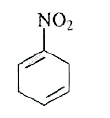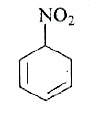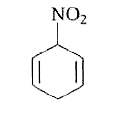Reduction of nitrobenzene by which of the following reagent gives aniline?
Sn/HCl
Fe/HCl
H2−Pd
Sn/NH4OH
The correct Answer is:A, B, C
To determine which reagents can reduce nitrobenzene to aniline, we need to understand the reduction process involved. The reduction of nitrobenzene (C6H5NO2) to aniline (C6H5NH2) involves the conversion of the nitro group (-NO2) to an amino group (-NH2). Here’s a step-by-step solution:
Step 1: Identify the Reduction Reaction
The reduction reaction we are looking at is:
C6H5NO2reductant−−−−−→C6H5NH2
Step 2: Choose Appropriate Reducing Agents
We need to select reducing agents that can facilitate the conversion of nitrobenzene to aniline. Common reducing agents for this reaction include:
- Tin (Sn) with hydrochloric acid (HCl)
- Iron (Fe) with hydrochloric acid (HCl)
- Hydrogen gas (H2) with palladium (Pd) as a catalyst
Step 3: Evaluate Each Option
1. Sn + HCl: Tin in the presence of hydrochloric acid can effectively reduce nitrobenzene to aniline.
2. Fe + HCl: Iron with hydrochloric acid also serves as a reducing agent to convert nitrobenzene to aniline.
3. H2 + Pd: Hydrogen gas with palladium as a catalyst can reduce nitrobenzene to aniline.
4. Sn + NH4OH: This combination does not provide the necessary acidic environment for reduction, as NH4OH is a base.
Step 4: Conclusion
The reagents that can reduce nitrobenzene to aniline are:
- A: Sn + HCl
- B: Fe + HCl
- C: H2 + Pd
The option that does not work is:
- D: Sn + NH4OH (this is not suitable for reduction).
Final Answer
The correct options are A, B, and C.
---
The reduction reaction we are looking at is:
C6H5NO2reductant−−−−−→C6H5NH2
We need to select reducing agents that can facilitate the conversion of nitrobenzene to aniline. Common reducing agents for this reaction include:
- Tin (Sn) with hydrochloric acid (HCl)
- Iron (Fe) with hydrochloric acid (HCl)
- Hydrogen gas (H2) with palladium (Pd) as a catalyst
1. Sn + HCl: Tin in the presence of hydrochloric acid can effectively reduce nitrobenzene to aniline.
2. Fe + HCl: Iron with hydrochloric acid also serves as a reducing agent to convert nitrobenzene to aniline.
3. H2 + Pd: Hydrogen gas with palladium as a catalyst can reduce nitrobenzene to aniline.
4. Sn + NH4OH: This combination does not provide the necessary acidic environment for reduction, as NH4OH is a base.
The reagents that can reduce nitrobenzene to aniline are:
- A: Sn + HCl
- B: Fe + HCl
- C: H2 + Pd
- D: Sn + NH4OH (this is not suitable for reduction).
The correct options are A, B, and C.
Topper's Solved these Questions
- AMINESBOOK - NCERT EXEMPLAR ENGLISHCHAPTER - AMINESEXERCISE - SATQ
37 Videos
- AMINESBOOK - NCERT EXEMPLAR ENGLISHCHAPTER - AMINESEXERCISE - LONG ANSWER
3 Videos
- ALDEHYDE, KETONES AND CARBOXYLIC ACIDSBOOK - NCERT EXEMPLAR ENGLISHCHAPTER - ALDEHYDE, KETONES AND CARBOXYLIC ACIDSEXERCISE - Long Answer Type Questions
4 Videos
- BIOMOLECULES BOOK - NCERT EXEMPLAR ENGLISHCHAPTER - BIOMOLECULES EXERCISE - Long Answer Type Questions
5 Videos
Similar Questions
Knowledge Check
Birch reduction of nitrobenzene will produce :
A B
B C
C D
D
Which of the following is more basic than aniline? .
View SolutionReduction of nitrobenzene with H2 in presence of platinum gives nitrosobenzene––––––––––––––––.
View SolutionWhich of the following reagent converts nitrobenzene to aniline?
View SolutionReduction of ketones canot be carried out with which of the following reagents?
View SolutionReduction of nitrobenzene in the presence of Zn/NH4Cl gives
View SolutionFrom nitration of aniline, which of the following steps is followed?
View SolutionWhich of the following statements are incorrect for aniline.
View Solution
